This article summarizes the simulated crop stages and yield forecasts performed on Aug. 23 for 40 locations across the U.S. Corn Belt using the UNL Hybrid-Maize crop model; the data can be seen in Table 1. Details on the underpinning methodology to simulate phenology and forecast end-of-season yields, as well as on interpretation and uses of yield forecasts, are described in a previous article.
Over the past three weeks, weather remained near the historical average except for a combination of high rainfall and low solar radiation in MO and parts of IL and IN. Overall, nighttime temperature matched historical records throughout the entire Corn Belt. A summary of weather conditions during the last three weeks is shown in Figure 1.
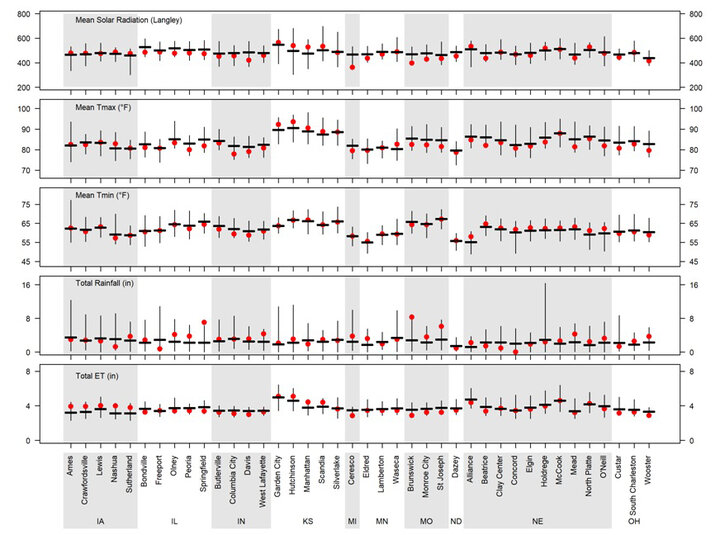
Table 1. Data from simulations of 2023 end-of-season corn yield potential and real-time crop stage performed on Aug. 23.
| Location | Water regime | Long-term average yield (bu/ac) § | Range of Yp forecasts as of Aug 23 (bu/ac)¶ 25th | Range of Yp forecasts as of Aug 23 (bu/ac)¶ 75th | Probability (%) of 2023 yield to be: Below (relative to the long-term Yp)† | Probability (%) of 2023 yield to be: Near (relative to the long-term Yp)† | Probability (%) of 2023 yield to be: Above (relative to the long-term Yp)† | Simulated current crop stage* | |
|---|---|---|---|---|---|---|---|---|---|
| NE | Alliance | Irrigated | 193 | 190 | 217 | 12% | 50% | 38% | R4, Dough |
| Beatrice | Dryland | 160 | 188 | 200 | 0% | 0% | 100% | R5, Dent | |
| Irrigated | 229 | 218 | 229 | 0% | 100% | 0% | R5, Dent | ||
| Clay Center | Dryland | 155 | 84 | 107 | 95% | 5% | 0% | R4, Dough | |
| Irrigated | 245 | 226 | 241 | 15% | 85% | 0% | R4, Dough | ||
| Concord | Dryland | 173 | 132 | 158 | 68% | 32% | 0% | R4, Dough | |
| Irrigated | 248 | 242 | 264 | 2% | 85% | 12% | R4, Dough | ||
| Elgin | Irrigated | 252 | 237 | 258 | 9% | 80% | 11% | R4, Dough | |
| Holdrege | Dryland | 112 | 107 | 130 | 0% | 66% | 34% | R5, Dent | |
| Irrigated | 242 | 231 | 254 | 11% | 74% | 14% | R4, Dough | ||
| McCook | Dryland | 86 | 99 | 107 | 0% | 0% | 100% | R5, Dent | |
| Irrigated | 224 | 205 | 221 | 10% | 90% | 0% | R5, Dent | ||
| Mead | Dryland | 181 | 202 | 214 | 0% | 17% | 83% | R5, Dent | |
| Irrigated | 234 | 228 | 242 | 0% | 98% | 2% | R5, Dent | ||
| North Platte | Dryland | 90 | 121 | 137 | 0% | 0% | 100% | R4, Dough | |
| Irrigated | 234 | 228 | 264 | 7% | 59% | 34% | R4, Dough | ||
| O'Neill | Irrigated | 226 | 230 | 260 | 3% | 53% | 45% | R4, Dough | |
| IA | Ames | Dryland | 228 | 215 | 228 | 6% | 91% | 3% | R5, Dent |
| Crawfordsville | Dryland | 227 | 165 | 178 | 100% | 0% | 0% | R4, Dough | |
| Lewis | Dryland | 205 | 201 | 210 | 0% | 100% | 0% | R5, Dent | |
| Nashua | Dryland | 228 | 170 | 188 | 97% | 3% | 0% | R4, Dough | |
| Sutherland | Dryland | 208 | 191 | 218 | 12% | 85% | 3% | R4, Dough | |
| IL | Bondville | Dryland | 235 | 237 | 252 | 0% | 81% | 19% | R4, Dough |
| Freeport | Dryland | 213 | 199 | 228 | 12% | 73% | 15% | R4, Dough | |
| Olney | Dryland | 191 | 212 | 217 | 0% | 21% | 79% | R5, Dent | |
| Peoria | Dryland | 211 | 238 | 253 | 0% | 10% | 90% | R4, Dough | |
| Springfield | Dryland | 182 | 223 | 233 | 0% | 0% | 100% | R5, Dent | |
| IN | Butlerville | Dryland | 224 | 221 | 231 | 0% | 90% | 10% | R4, Dough |
| Columbia City | Dryland | 224 | 251 | 270 | 0% | 20% | 80% | R4, Dough | |
| Davis | Dryland | 230 | 247 | 260 | 0% | 55% | 45% | R4, Dough | |
| West Lafayette | Dryland | 236 | 239 | 253 | 0% | 85% | 15% | R4, Dough | |
| KS | Garden City | Irrigated | 217 | 194 | 205 | 27% | 73% | 0% | R5, Dent |
| Hutchinson | Dryland | 99 | Black layer on Aug. 10. Final yield: 97 bu/ac | Matured | |||||
| Manhattan | Dryland | 137 | Black layer on Aug. 16. Final yield: 160 bu/ac | Matured | |||||
| Scandia | Dryland | 129 | 96 | 97 | 100% | 0% | 0% | R5, Dent | |
| Irrigated | 226 | 202 | 210 | 41% | 59% | 0% | R5, Dent | ||
| Silverlake | Dryland | 141 | Black layer on Aug. 18. Final yield: 164 bu/ac | Matured | |||||
| Irrigated | 209 | 210 | 215 | 0% | 100% | 0% | R5, Dent | ||
| MI | Ceresco | Dryland | 180 | 182 | 215 | 5% | 32% | 64% | R3, Milk |
| MN | Eldred | Dryland | 114 | 80 | 106 | 59% | 41% | 0% | R4, Dough |
| Lamberton | Dryland | 212 | 187 | 202 | 42% | 58% | 0% | R4, Dough | |
| Waseca | Dryland | 219 | 199 | 213 | 23% | 77% | 0% | R4, Dough | |
| MO | Brunswick | Dryland | 181 | 94 | 97 | 100% | 0% | 0% | R5, Dent |
| Monroe City | Dryland | 175 | 134 | 138 | 100% | 0% | 0% | R5, Dent | |
| St. Joseph | Dryland | 169 | 205 | 210 | 0% | 0% | 100% | R5, Dent | |
| ND | Dazey | Dryland | 108 | 84 | 120 | 39% | 36% | 25% | R4, Dough |
| OH | Custar | Dryland | 208 | 219 | 239 | 3% | 45% | 53% | R3, Milk |
| South Charleston | Dryland | 216 | 220 | 248 | 3% | 55% | 42% | R4, Dough | |
| Wooster | Dryland | 210 | 194 | 229 | 16% | 66% | 18% | R2, Blister | |
§Long-term (last 20-plus years) potential yield at each location and surrounding area.
¶ Range of forecasted 2023 potential yields based on average planting date in 2023, indicating the potential yields in the 25th and 75th percentile of the potential yield distribution (associated with respective adverse and favorable weather scenarios during the rest of the season).
† Probability of obtaining a 2023 yield below (10%) than the long-term potential yield at each location.
Simulated Corn Stage Across 40 Locations
Corn has entered the dough stage across a majority of sites, except for three sites in the eastern fringe of the region. At this point, corn has reached kernel dent stage in central to southern regions of the Corn Belt, and has even reached black layer at three sites in KS (Figure 2). Current corn stage is similar to that reported by mid-August last year.
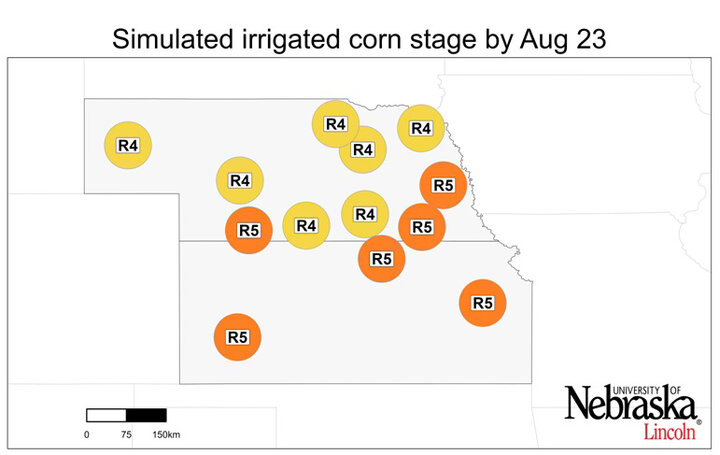

Irrigated Corn: Near or Below-average Yields are Expected
The forecasted range of irrigated corn yield potential for each location, along with the probabilities for yields above, near or below average, are shown in Figures 3 and 4. Most irrigated sites (eight out of 13) show a high probability (>75%, that is, three out of four chances) of near-average yield potential. Near-average yield is also likely in the rest of the sites. At this point, the forecasted scenario for irrigated maize in the current season appears more favorable than that of 2022.
Rainfed Corn: Yield Potential is Highly Variable Across Rainfed Sites
Forecasted yield potential is highly variable across the 35 rainfed sites (Figures 3 and 4). Consistent with our previous forecast, two distinct regions have a high probability of experiencing below-average yields. The first region includes portions of ND, MO and eastern IA, while the second covers the northeastern and south-central areas of NE, along with north-central KS. Compared with our previous forecast, the environmental conditions during the past three weeks have increased the probability of above-average yield potential in the eastern states (most of IL, IN and OH). Overall, 11 sites distributed across IL, IN, NE, KS and northwestern MO have a high probability (>75%, that is, three out of four chances) of above-average yields (Figures 3 and 4). Additionally, seven sites, primarily situated in western IA and the eastern part of the Corn Belt (IN and IL), exhibit a high probability of achieving near-average yields.
Spanning from west to east and in comparison with the 2022 forecast, the forecasted scenario for rainfed maize appears to be more favorable in the western region (NE, ND, northern MN, and most of IA and KS), more pessimistic in central areas (MO, northeastern IA, south of MN, and western IL), and largely similar in the eastern fringe of the Corn Belt (IL, IN, MI and OH).
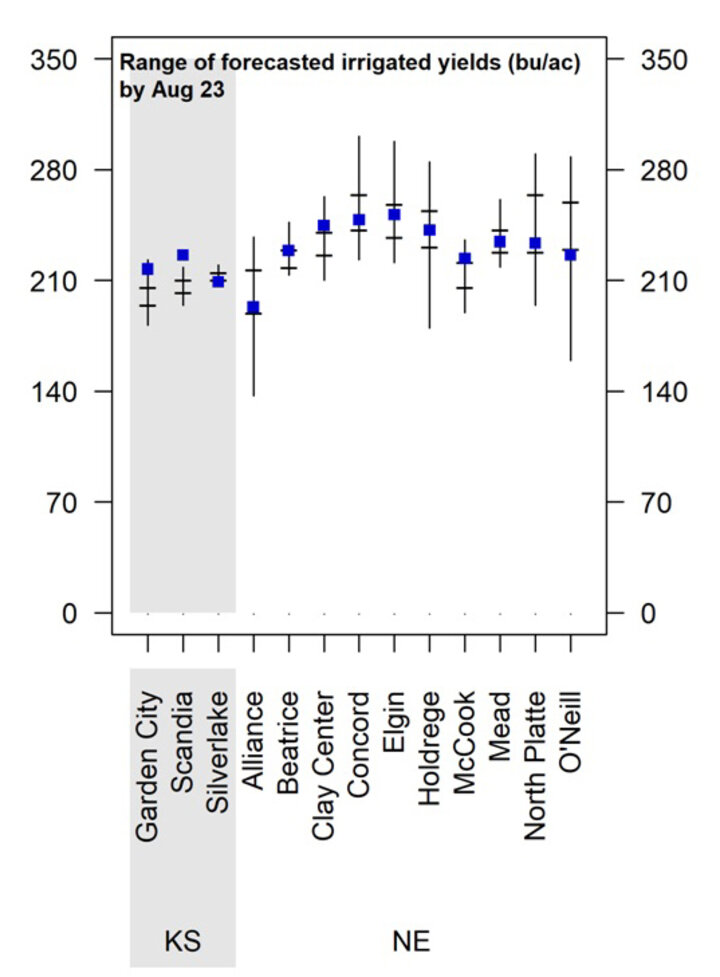
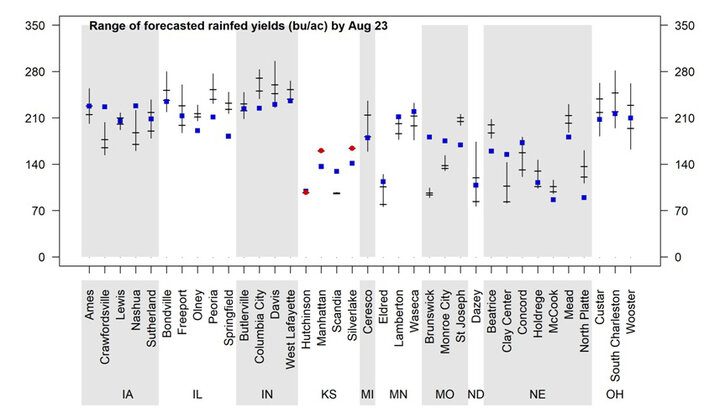
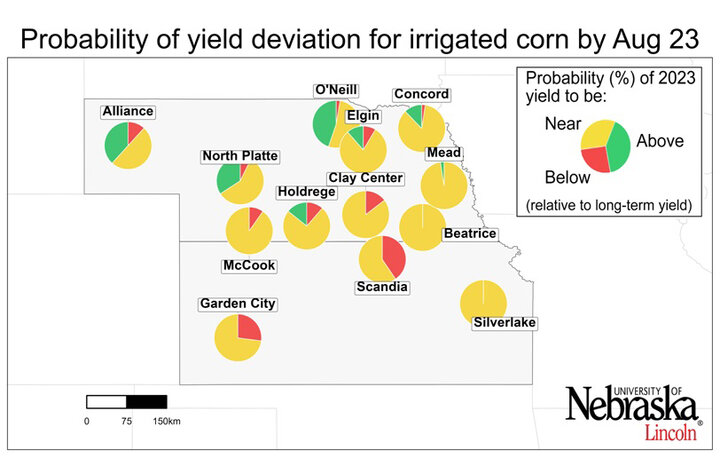
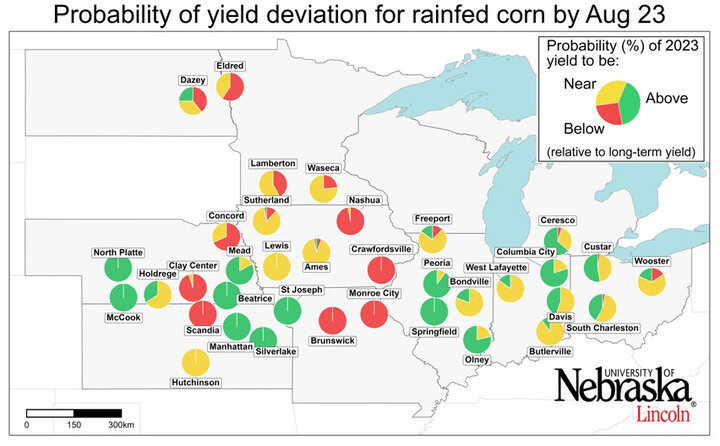
Conclusions
Corn has already reached the dough stage across the majority of the Corn Belt, while dent stage (or even black-layer) has been attained in the southern fringe of the region. When compared to our previous forecasts, most sites in the eastern part of the Corn Belt have increased the likelihood of achieving near or above-average yields. Temperature and rainfall during the rest of August will likely determine the trend for the eastern fringe of the Corn Belt. Moreover, above-average yields are also expected at a few spots in NE, KS and northwestern MO.
In contrast, two regions, one in south-central NE and north-central KS, and the other in MO, eastern and northern IA exhibit a high probability of below-average yields.
Overall, the regional average yield this season is expected to be near the historical average (
These forecasts do not take into consideration problems with stand emergence, hail/flooding damage, replanting situations, disease or nitrate leaching. In fields negatively affected by these constraints, actual yields will be lower than estimates provided here.
It is important to keep in mind that yield forecasts are not field specific and, instead, represent an estimate of average on-farm yield for a given location and surrounding area in absence of the yield-reducing factors mentioned here. Likewise, crop stages and forecasted yields will deviate from those reported here in fields with planting dates or hybrid maturities that differ markedly from those used as the basis for these forecasts. We will follow up with the final forecasted yield and analysis of the 2023 crop season in September.
